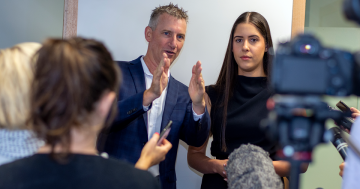Ashley Stahl*, a seasoned public speaker, has some valuable advice for those about to give their first presentation.
 Your palms are sweating, your heart is racing and your mouth is drying out.
Your palms are sweating, your heart is racing and your mouth is drying out.
You are about to step up to give a speech or presentation in front of people, and you’d really be somewhere else.
Welcome to the club.
Roughly 75 per cent of people have speech anxiety, making it one of the most common fears.
However, the workforce finds value in public speaking, with 70 per cent of employees declaring compelling presentation as a crucial skill to succeed.
As a professional public speaker, these nerves are even something I’ve had to overcome, and let me tell you the dreaded secret: They never end.
That means your salvation as a speaker is in learning the art of speaking, and most of all, learning how to channel your nerves into excitement and positive energy.
Know your time constraints
A public speaking moment is not the time to dive into all the research, or all the details of a project.
Keep things high level and dip into the details when needed. An audience wants a story and message it can easily learn from, not a State of the Union address.
Consider who you are speaking to when you prepare your speech.
Ask yourself how informed your audience will be on your topic, and what information it will most likely want to learn about.
Break your speech up into short stories to either explain a topic, provide advice or deep insights.
As a rule of thumb, try not to cover more than three points if you only have 10-to-15 minutes, and try not to cover more than five points if all you have is 45 minutes.
These frameworks provide a good structural approach.
Retaining attention is difficult when you consider that on average your audience is experiencing lapses into distraction every two or three minutes.
The best way to reduce this loss of attention is by asking questions and conducting demonstrations as opposed to standing still and talking like a robot.
Learn how to tell a story
How do you tell an effective story? There are a few key tools: Emotional contrast, vulnerability, and open loops to name a few.
I opened up my most recent TEDx talk sharing about the moment my dad picked up the phone and heard a kidnapper on the other end of the line.
What happened? I’d tell you, but instead I’ll leave this as an open loop.
See what I mean? Opening someone’s curiosity early into the story without fully feeding is it a powerful way to keep attention.
On top of that, vulnerability always wins. People want to relate, and that starts with you getting into your honesty while you’re on stage.
A ground-breaking study found that sharing personal and emotional experiences with a stranger for only 45 minutes makes you 30 per cent more connected to that person than someone you have known for years.
Finally, emotional contrast is powerful.
That looks like sharing a story with unexpected highs and lows, or showing two sides of yourself.
For example, I worked in counter-terrorism, but I also am a career coach who likes rap music, fashion and dancing.
Show diversity or contrast within who you are and the story will keep their attention.
Don’t think you’re that interesting? Ask friends or family what they notice about you. Sometimes it’s hard to realise your own magic.
Practice on video
Roughly 65 per cent of people are visual learners, which means you learn best by watching something get done.
When you see yourself on video, know you will learn a lot about your movement, and your nervous ticks.
Record yourself running through a practice run of the presentation, and pay close attention to your body language, your movement, the tone of your voice and the speed at which you talk.
A rule of speaking is to never move on stage without a purpose. Pacing is for rookies. Don’t do it.
Also, be sure to keep your body language open and speak at a consistent cadence.
Don’t cross your arms and legs like a pretzel on stage, and don’t stand leaning on one leg, looking like you’re waiting in line for a quick hot dog at a food truck.
Most of all, know the power of silence and pauses. Take breaks in between statements or topics.
Reframe the nerves into excitement
When I was standing backstage before giving my very first TEDx talk, I was surrounded by professional speakers and guess what?
Even the most seasoned of speakers appeared to have some serious nerves. Instead of allowing these emotions to consume you, harness them into excitement.
One way to do this is to focus on the audience you are speaking to, rather than the speech itself.
The truth of the matter is that nerves usually indicate that you’re too focused on how you look, versus being making sure you’re focusing on your listener.
So take those nerves as feedback to stop focusing on you and start focusing on your audience.
Try thinking of one person and how you want your message to help them, or teach them.
When you focus on the purpose, the speech itself won’t feel as daunting.
Don’t ever forget, you are not alone in this. Your audience is rooting for you, and wants to watch you succeed just as much as you do.
Have fun with the opportunity and be proud of yourself for stepping up and onto the platform.
*Ashley Stahl is a career coach, keynote speaker, podcast host (You Turn Podcast) and author. In a previous life she was award-winning counter-terrorism professional. She can be contacted at ashleystahl.com.
This article first appeared at forbes.com.










